|
| 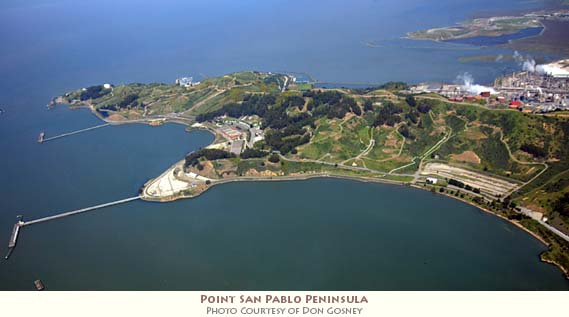
Recent articles in the SF Chronicle by David Helvarg(“Don't gamble with Point Molate” and “Build Waterfront Park, Not Homes, at Point Molate”) both copied at the end of this email, are gross misrepresentations of reality and are part of a recent frenzy to protect Point Molate from a non-existent threat.
Mr. Helvarg seems to be totally confused about what is going on with Point Molate. He seems to believe that Point Molate is still being considered as the location for a casino. Helvarg writes, “…the City Council could vote to transfer Point Molate's title to Upstream LLC, a consortium put together by a Berkeley developer who also represents a small band of Pomo Indians that he hopes will become California's next gaming tribe.”
The fact is that the casino proposal has been dead since 2011, and it is not coming back.
We also had a number of speakers at City Council meeting last Tuesday night, most accusing the City Council of making some kind of secret deal with Jim Levine. This myth is being largely pushed by the RPA, with Gayle McLaughlin stating, “Many feel strongly that the City Council is heading back into those historically corrupt days in Richmond before some of us got involved. Richmond was known, in those days, for handling big issues behind closed doors.”
As much as we appreciate the RPA for single-handedly saving us from those “historically corrupt days in Richmond,” Mc Laughlin knows better. No decision has been made by the Richmond City Council other than to simply hear what Levine has to say.
What we are seeing is the manifestation in emails to Council members, public speakers at City Council meetings and newspaper articles planted by the RPA, of a subtle agenda to make drastic changes to the vision of Point Molate’s future that has endured for nearly twenty years. Next to doing nothing at Point Molate, the RPA and their collaborating activists appear to be dead set against any housing at Point Molate and are suspicious of any economic activity at all.
Mr. Helvarg appears to be the media spokesperson for that agenda, but it’s not even clear what he wants to see at Point Molate. He cites the Presidio and Ft. Baker (now called Cavallo Point) as examples we should follow, and they are both excellent ones. Helvarg writes, “I'm thinking this could be the third emerald jewel of bayfront green parks, along with the Presidio of San Francisco and Fort Baker in Marin County. Unfortunately, with its multimillion-dollar views of San Francisco Bay and Mount Tamalpais, Point Molate has generated a more predictable plan.”
Neither Cavallo Point nor the Presidio, however, are undeveloped parklands. Cavallo Point incudes a large conference center, hotel restaurant and bars along with the Bay Area Discovery Museum and a marina. Helvarg, along with anti-housing Point Molate activists, eschews housing at Point Molate, but apparently is not aware that his beloved Presidio has 3,000 people living in 1,200 housing units in in 21 neighborhoods.
Turning Point Molate into one giant park with decaying ruins of a National Register Historic District is clearly not what former Congressman Ron Dellums had in mind when he authored the DOD Authorization for Fiscal Year 1996 (Public Law 104-106), signed into law by President Clinton. The Dellums legislation permitted DOD to convey Point Molate to the City of Richmond at no cost. The conveyance was, however, not without conditions. One of the conditions required use of the parcel for “economic development.”
CONDITION OF CONVEYANCE.—The conveyance authorized under subsection (a) shall be subject to the condition that the City, directly or through an agreement with a public or private
entity, use the conveyed property (or offer the conveyed property or use) for economic redevelopment to replace all or a part of the economic activity being lost at the parcel.
Self-appointed critics of development at Point Molate have also been dismissive of the 1997 Reuse Plan, but after nearly 20 years it remains an excellent guide. The plan was required by the Navy as a condition of transfer, as was a 25-person Blue Ribbon Committee to advise on its preparation. Ultimately, it was approved unanimously by the City Council.
In its “Vision” statement the Reuse Plan states:
Point Molate will play an important role in enhancing the economic base of Richmond, enhancing Richmond’s regional presence, expanding open space and recreational opportunities and creating a new City neighborhood with a mix of uses…The overall vision, thematic concepts, and specific recommendations of the Plan are consistent with President Clinton’s Five Point Plan for achieving successful conversion and reuse of military bases, which emphasizes job creation and economic development.
A number of years ago, the City Council adopted The Ahwahnee Principles as a design guide, and those Principles are cited in the General Plan 2030 (General Plan 2030 (Introduction – Shaping the New 100 Years, page 9) as a basis for the General Plan. The first Ahwahnee Principle is:
All planning should be in the form of complete and integrated communities containing housing, shops, work places, schools, parks and civic facilities essential to the daily life of the residents. What Helvarg says he wants to do is totally consistent with both the 1997 Reuse Plan and even Upstream’s opening proposal:
A far more credible plan might focus on Point Molate’s existing historic district that could and should be repurposed from the state’s original wine industry port (not far from the state’s last whaling station) to something both useful and fabulous. This 20-acre plus site includes the red brick Winehaven Castle and an adjacent turn-of-the-20th-century workers village. It has potential for a Mount Tamalpais-bayview hotel, food and wine retail shops, start-up offices, a plant nursery, nature center, etc. As a visitor destination, it would have increased value being surrounded by a waterfront park, an extended Bay Trail, hiking trails, native grasslands and family camping sites.
Another thing Helvard wrote about is the myth that deep pocketed organizations are beating down our door to invest in Point Molate. He writes:
Among those who have expressed interest in managing these natural treasures are the East Bay Regional Parks District and the Trust for Public Lands, while San Francisco State’s Romberg Marine Lab and the nonprofit Watershed Project hope to continue to study and restore Point Molate’s offshore eelgrass beds and historic oyster reefs. A coalition of Richmond and Bay Area political and conservation groups are also coalescing in opposition to the mayor’s planned housing deal with a developer whose previous plans were overwhelmingly rejected by voters. As far as I know, the East Bay Regional Park District has not offered a penny to manage anything at Point Molate. This coalition Helvarg speaks about is long on “no” and short on both money and action.
Point Molate should be envisioned as a neighborhood, not just an enclave where the gates are locked at sundown. Including a significant residential component will give Point Molate a critical mass that will make it a 24/7 community, not just a place. Residents will provide the critical “eyes on the street,” to quote perhaps America’s most famous planner, Jane Jacobs, in “The Death and Life of Great American Cities.”
Point Molate is no longer just a place, it’s become a game of political football where political factions are vying to see who can score the most points.
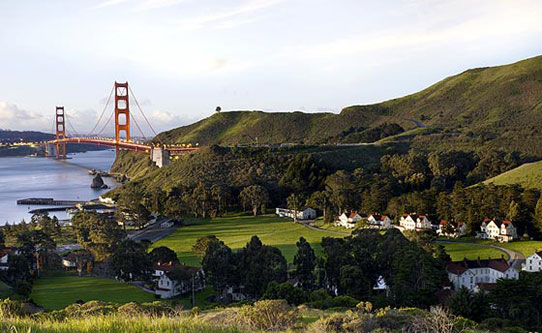
Above, Cavallo Point (formerly Ft. Baker)
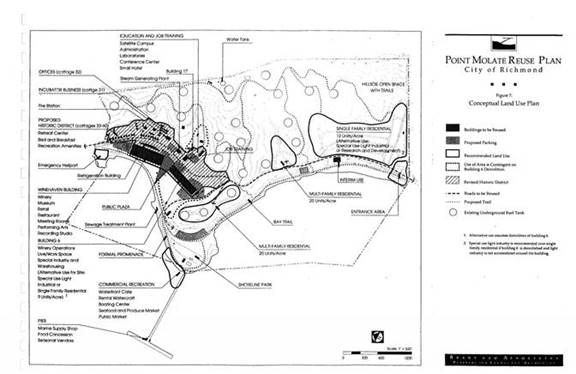
Above, the 1997 Point Molate Reuse Plan includes most of the features both the Presidio and Cavallo Point, including hotels, housing, commercial ventures, parks and open space.
Don't gamble with Point MolateDavid Helvarg
Published 4:00 am, Friday, January 8, 2010
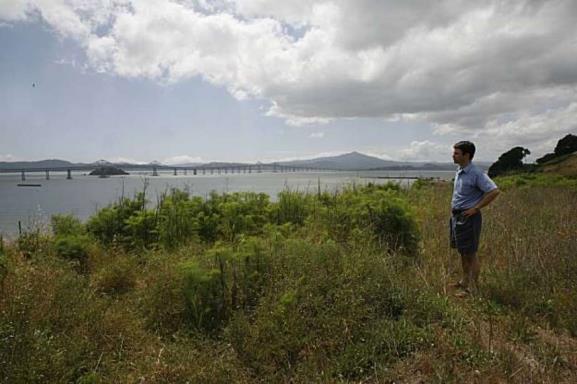
Photo: Frederic Larson, The Chronicle
As a Richmond resident, it took me some time to discover one of my city's treasures, the headlands north of the Richmond Bridge known as Point Molate, 422 acres of spectacular bay-facing green space and submerged eel grass meadows that my City Council wants to sell off for a gambling casino.
Point Molate is the site of an historic wine port that later became part of a Navy fuel oil depot before the U.S. Navy sold it to the city for $1 in 2003. It is an example of the resiliency of nature left unpaved, rapidly reclaiming its terrestrial area as hilly coastal grassland, range-managed by mule deer with colossal toyons - Christmas berry shrubs - the size of live oaks, also live oaks, federally protected Suisun marsh aster, native Molate blue fescue, a unique bunchgrass horticulturists have bred for landscaping, coyote brush, wild mint, Dutchman's pipe vine and its rarely seen companion, the pipe vine swallowtail butterfly. "This is the most beautiful area imaginable for grassland geeks," botanist Lech Naumovich, who is showing me around, grins happily.
I'm thinking this could be the third emerald jewel of bayfront green parks, along with the Presidio of San Francisco and Fort Baker in Marin County. Unfortunately, with its multimillion-dollar views of San Francisco Bay and Mount Tamalpais, Point Molate has generated a more predictable plan.
Sometime in the next 10 weeks, and despite opposition from Richmond's mayor, the governor, the state's two U.S. senators, and what seems to be a lot of Richmond residents, the City Council could vote to transfer Point Molate's title to Upstream LLC, a consortium put together by a Berkeley developer who also represents a small band of Pomo Indians that he hopes will become California's next gaming tribe.
Upstream has already paid the city a $15 million nonrefundable deposit toward a possible $50 million purchase price, promising to build the most eco-sustainable casino, hotel and housing complex this side of Las Vegas.
The developer has promised tens of millions more dollars from imagined future gambling revenues to the city, county, environmental critics and others. Along with the land transfer, Secretary of Interior Ken Salazar would have to agree to convert Point Molate into reservation land for urban gaming. If he doesn't, Upstream could turn around and sell the land to a third party, such as Chevron Corp., which has a huge production facility just over the ridgeline.
Some on the City Council seem to take the promise of casino jobs for maids and security guards as the best they can provide their low-income constituents, even though I see no indication that this is what the people of Richmond support.
Far more promising is the job-generating capacity of working parks like the Presidio and Fort Baker. In Fort Baker, along with a Coast Guard station, marina and the Bay Area Discovery Museum, there is Cavallo Point Lodge, a destination luxury resort that was built on a historic site within the park but that didn't require loss of public ownership, affecting offshore habitat, paving over a major watershed, installing thousands of slot machines or generating traffic to achieve success.
While our recession-and addiction-plagued city and state already have dozens of casinos, there's only one large green space left on the West Coast's largest estuary that could act as a local and world center for providing natural ecosystem services, youth recreation, education, jobs and opportunities as could Point Molate Park.
Build waterfront park, not homes, at Point MolateBy David Helvarg
July 18, 2016 Updated: July 18, 2016 8:41pm
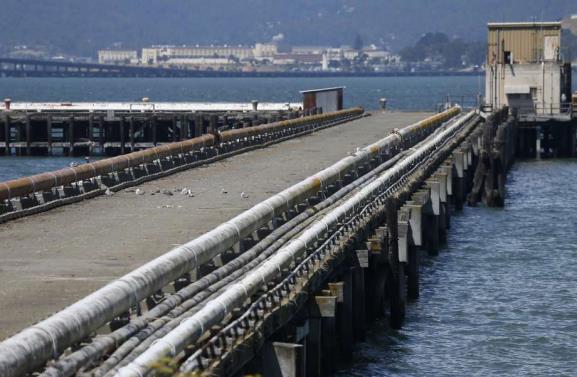
Photo: Paul Chinn, The Chronicle
Pipelines from the old Navy fuel depot line a pier at Point Molate in Richmond, Calif. on Friday, July 15, 2016.
In the wake of the firing of the executive director of the California Coastal Commission earlier this year, real-estate interests in the state seem emboldened to push for badly thought out but highly lucrative waterfront developments.
A case in point is my town of Richmond. Six years ago, the people of Richmond voted 58 percent to 42 percent to stop a mega-casino development planned for Point Molate, a 422-acre natural headland and historic wine port that, in the words of one local, “is the most beautiful part of the Bay Area no one’s ever heard of.”
The casino developer, not seeming to understand his own business model that when you gamble you lose, went on to sue the city. For six years, federal judges have ruled against him, his Upstream development company and the tribe they’d partnered with including in 2015 when they were ordered to pay close to $2 million in attorney’s fees to the city.
Yet now Richmond Mayor Tom Butt is working to cut a deal that has included two city council closed sessions in June and one July 19 with the former casino developer, Jim Levine. Apparently the mayor hopes to settle the suit the city’s been winning by giving part of Richmond’s greatest natural resource back to Levine.
Point Molate
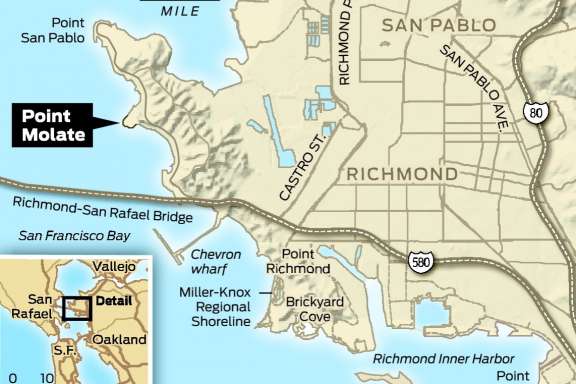
Former Navy fuel depot holds promise for new use in Richmond
Ongoing private discussions have taken place between the mayor, Levine and others to put 1,100 high-income housing units on Point Molate’s isolated and largely inaccessible peninsular headland. The five proposed housing clusters would include Marin-view mini-mansions on the slopes of the only intact California coastal grasslands watershed in the East Bay that runs down to San Francisco Bay’s healthiest offshore eel grass beds.
In 2014, former mayor and now Richmond City Councilmember Gayle McGlaughlin opened up a public beach park at Point Molate for the first time in a decade. She also established a Point Molate Community Advisory Committee made up of a dozen local citizens who have volunteered their time, efforts and oversight for six years. At the same time, Citizens for a Sustainable Point Molate, a volunteer group that I work with, has been sponsoring daylong field trips for Richmond high school classes that have helped inspire and reconnect our young people with their waterfront while learning about science, health, botany and biology. Some students saw their first seals, deer and other native wildlife. For most of the students, this has been a first-time exposure that’s elicited excited feedback including whoops of joy when, in the middle of an outdoor class, an osprey snagged a fish out of the water with its talons.
Most people don’t associate our low-income city with world-class history and natural wonders but those of us who’ve been working to protect Point Molate for the last decade have a vision on how to develop the site as a self-supporting waterfront park, along with a thriving commercial and retail district. Unfortunately, the city attorney has repeatedly warned the advisory committee not to entertain any development plans because of Levine’s ongoing litigation while the mayor complains that he has to take precipitous action because, “nothing is happening at Point Molate.”
The mayor met with PG&E last year and was told it would cost at least $25 million to bring power onto Point Molate, a good argument for putting private housing on the land to pay for that type of costly capital improvement. When the Trust for Public Land brought in the Urban Land Institute for a quick evaluation (paid for by the trust and the city) Mayor Butt told them that, given PG&Es projected energy costs, housing would be the only practical development plan. The Urban Land Institute provided two plans that reflected the mayor’s wishes for housing, although not in the native grassland watershed or other high-value natural resource areas that the Levine plan has marked for development.
However Mark Howe, a member of the advisory council and a businessman who leases out commercial properties in Richmond, found an existing PG&E power line that runs through Chevron’s property that could re-energize Point Molate for around $300,000. This lesser cost could be covered by temporarily leasing some of the existing buildings and paved spaces on site until a public and transparent plan for sustainably developing this bay area wonder is completed, a plan that might also incorporate clean energy generated by wind or solar.
In addition, rejecting the idea of private housing clusters where they don’t belong would reduce a huge liability risk associated with Chevron’s giant aging oil refinery that sits just over Point Molate’s ridgeline.
A far more credible plan might focus on Point Molate’s existing historic district that could and should be repurposed from the state’s original wine industry port (not far from the state’s last whaling station) to something both useful and fabulous. This 20-acre plus site includes the red brick Winehaven Castle and an adjacent turn-of-the-20th-century workers village. It has potential for a Mount Tamalpais-bayview hotel, food and wine retail shops, start-up offices, a plant nursery, nature center, etc. As a visitor destination, it would have increased value being surrounded by a waterfront park, an extended Bay Trail, hiking trails, native grasslands and family camping sites.
Among those who have expressed interest in managing these natural treasures are the East Bay Regional Parks District and the Trust for Public Lands, while San Francisco State’s Romberg Marine Lab and the nonprofit Watershed Project hope to continue to study and restore Point Molate’s offshore eelgrass beds and historic oyster reefs. A coalition of Richmond and Bay Area political and conservation groups are also coalescing in opposition to the mayor’s planned housing deal with a developer whose previous plans were overwhelmingly rejected by voters.
Instead all interested parties could and should work through a democratically elected community trust for Point Molate involving all the city’s stakeholders, and not least our students and youth who have the greatest stake in what kind of resources and opportunities they inherit. All that’s needed to restore Point Molate’s unique gifts to the people of Richmond and the world is democracy, imagination and a city council willing to stand up to its mayor.
David Helvarg is a Richmond resident, executive director of Blue Frontier, an ocean conservation group, and the author of “The Golden Shore — California’s Love Affair with the Sea.” |
|

